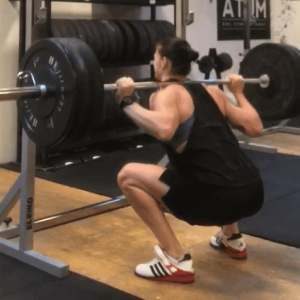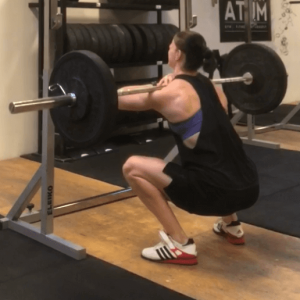Written By Christy Bacon, CSCS
SQUATS
The squat is one of the most important fundamental movements when it comes to training. It is a compound exercise that includes several different joints as well as activating almost every muscle in the body. Back squats and front squats are two of the most popular versions of this foundational exercise, and they work your major muscle groups in different ways. By understanding the differences between them, you can decide which squat is best for you.
BACK SQUAT
In a back squat, the bar is placed on the back, either sitting on top of the traps (high-bar position) or a bit lower on the rear delts (low-bar squat). The high-bar squat allows your torso to stay more upright and causes you to activate your quads more while the low-bar squat forces you to lean forward more on the descent which activates the hamstrings more. With the start position of the back squat, you will typically see the lifter leaning forward at the hip joint (flexing) in order to keep the bar over the mid-foot. The feet should be placed in a comfortable position that not only suits the lifter’s hip anatomy, but also promotes the most neutral spine position for as much of the body’s descent as possible. Range of motion in the ankles is a primary determinant as to how far the lifter needs to push the hip back in order to balance out the weight through the squat. If there is little range of motion in the ankles, the knees cannot go over the toes very far which makes the lifter push the hips back and lean more forward during the descent of the squat. The lifter can help keep the torso more upright by turning the toes out and pressing the knees out during the descent and ascent of the squat. By turning out the toes and pressing out the knees, the lifter shortens the distance from the knee (hinge) to the mid-foot where the load is aligned. Turning out your feet in ANY type of squat is also advantageous because it places the body in the best anatomical position to lift heavier weight. During the squat movement itself, the torso angle will be deeper to accommodate the bar’s positions. Depending on the lifter’s levels of mobility and leverages, this torso angle can be more or less severe when looking for a deep range of motion. As compared to the front squat, which requires a more vertical torso position to perform correctly, the back squat results in an increase in hamstring tension, lumbar spine stress, and overall posterior chain involvement.

FRONT SQUAT
In the front squat, the bar is placed in front of the body on the shoulders by either using the clean grip or by crossing the arms in front and placing the hands on top of the bar. Either grip demands that you keep your elbows up throughout the entire movement. Keeping the elbows up is what creates the “shelf” on the shoulders for the bar to sit on. The clean grip offers more stability but demands a level of flexibility through your shoulders and wrists. If you don’t have that flexibility, the cross-arm position would be the better option at the moment. You will sacrifice a bit of stability in this position until you become used to it, but it offers more activation of the core since you can’t “cheat” by dropping the elbows a bit on the ascent of the squat as you can with the clean grip. When a lifter places the bar in the front rack position on the shoulders, it creates an instant forward shift in the center of gravity. To keep the bar consistently over the mid-foot, it requires keeping the torso much more upright compared to back squats. The ideal start position of the front squat sees no hinge at the hip. Initiating the movement will drive the knees forward as the hips drop down and back, much more simultaneously than during the back squat. This position may increase quadriceps involvement and also potentially decrease the lumbar stress since the upright torso asks for greater anterior knee displacement. Typically, a lifter of the same mobility as the back squat example would be able to achieve greater depth using front squats, with all things equal.

Muscles used in back squat and front squat, written in order of activation.
Muscles used in Back Squat: glutes, hamstrings, quadriceps, lower back (spinal erectors), upper back, abdominals, shoulders
Muscles used in Front Squat: quadriceps, glutes, hamstrings, abdominals, lower back (spinal erectors), upper back, shoulders.
As you can see, the same muscle groups are being activated in both types of squats, but the amount of activation of these muscle groups changes in each type of squat. Back squatting emphasizes the posterior chain—the large muscle groups of the back, glutes, and hamstrings. Front squatting recruits the chain of your body’s anterior muscles more heavily, engaging the quads and core to a greater degree. Doing back squats will allow you to train with heavier weight which in turn will help you get stronger faster, but if you have problems with your lower back, you may want to do the front squats instead. I include both front squats and back squats in my training in order to place greater emphasis on different parts of the body.
Hopefully I was able to shed a bit of light on the differences between the back squat and the front squat. I hope that this information helps you in planning your training programs in the future!


